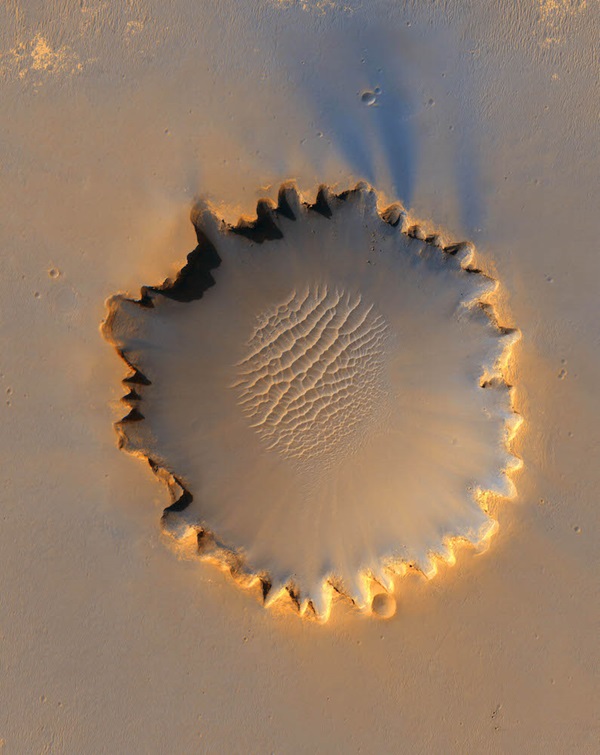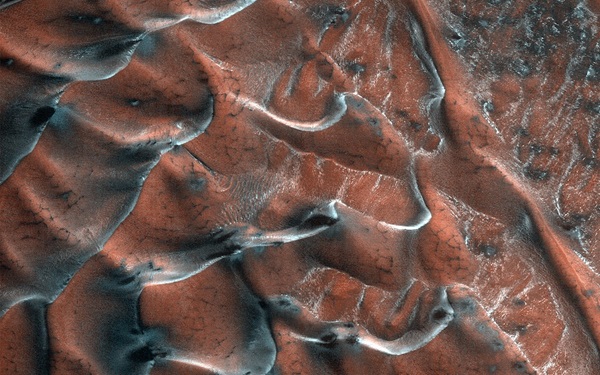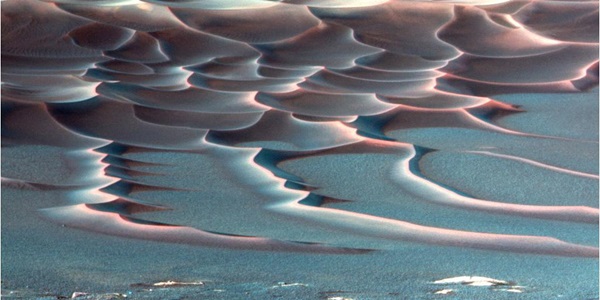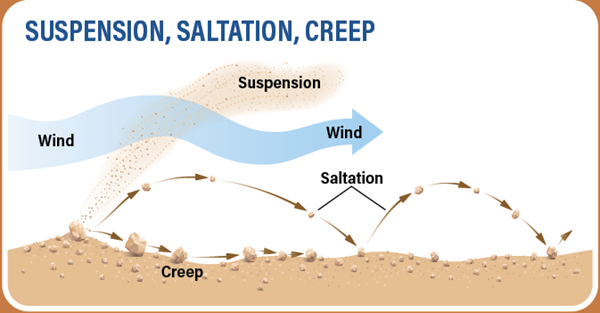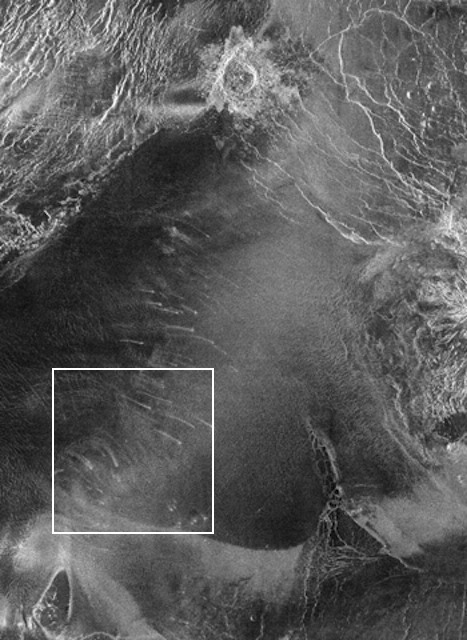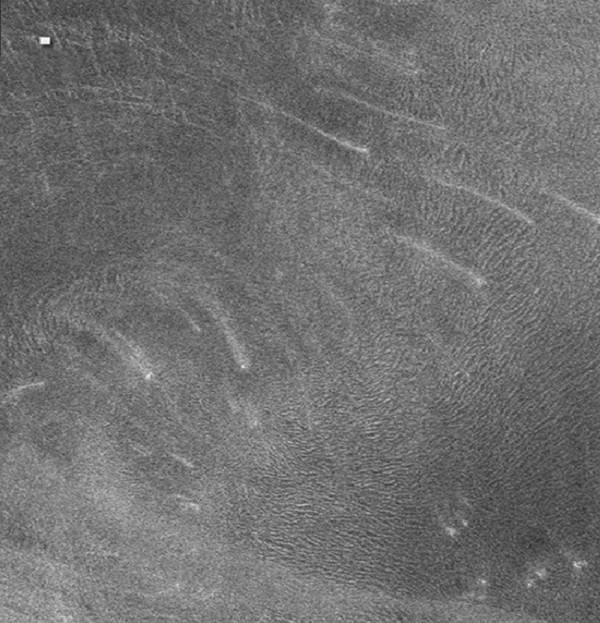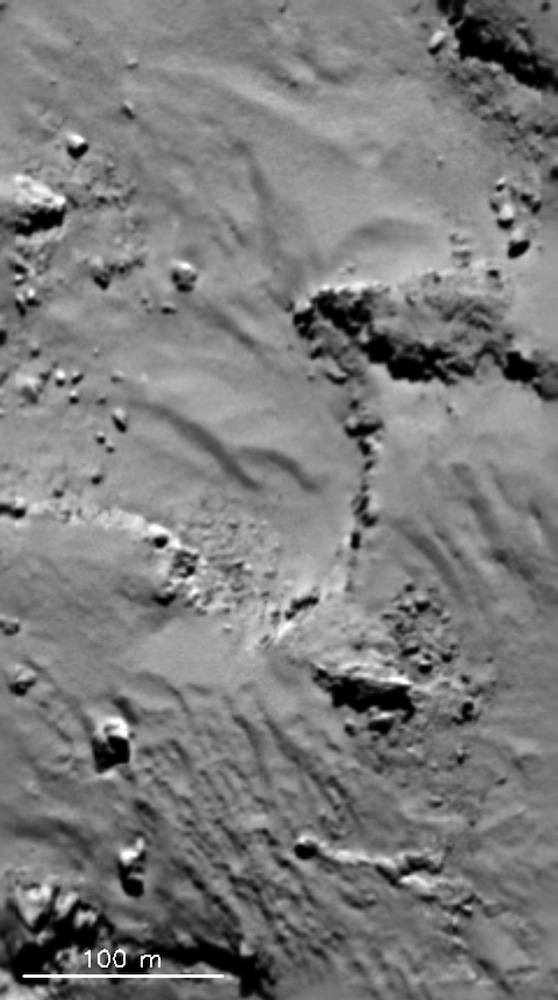Key Takeaways:
Dunes of sand sweep across the solar system, building drifts on any world with even the slightest hint of a breeze. Some look like the features we’re familiar with on Earth, made up of bits of rock or ice, while some appear far more alien, built solely from organic material. From Mars to Pluto to tiny comets, the wide variety of dunes scientists see may help refine outstanding questions about how dunes form on Earth, along with providing information about past and present conditions on distant worlds.
Studying dune patterns can reveal not only insights about a body’s surface composition, but also hint at its atmospheric history. Thinner atmospheres make it harder to toss particles into the air, so ancient dunes can reveal how sand rained from the sky when thicker gases blanketed a world. This can be critical on bodies like Mars, whose hefty atmosphere slowly escaped over time, and Pluto, whose atmospheric density grows and shrinks as it travels around the Sun.
How to build a dune
On Earth, sand is commonly built by eroding quartz. But it can also comprise shells, coral, carbonate, volcanic ash, and even ice. That means sand can develop and settle not only in beaches and deserts but also in the frozen barrens of Antarctica. Furthermore, the definition of sand has nothing to do with composition and everything to do with size and how it is transported: particles that are small enough and light enough to be lofted into the air. On Earth, that’s around 0.0025 to 0.08 inch (0.06 to 2 millimeters) in diameter. On other worlds with less gravity, sand particles can be larger.
So, how do you go from particles of sand to rippling dunes? The key to dunes is wind. “As long as there’s movement of air molecules, we … end up with an aeolean field,” or a landscape sculpted by wind-deposited sand, says Jani Radebaugh of Utah’s Brigham Young University. (Aeolean refers to the Greek god of wind, Aeolus.)
Despite their compositional variety, dunes on Earth all form under roughly the same conditions and are limited primarily by gravity, which affects how far sand can fly. By looking at the wide variety of dune-covered solar system worlds, scientists hope to get down to the nitty-gritty of how sand dunes form and shift. The basic idea is simple: Wind carries sand across the surface, eventually piling it up in dunes. But the details are where things get messy. Is the sand following a fluid dynamic model, traveling through the air much as it swims through water to create water-sculpted dunes? Or does it obey an impact mechanism model, where the first grain of sand lifted by the wind kicks up other grains that go on to kick up even more?
According to Serina Diniega, a researcher at the Jet Propulsion Laboratory in Pasadena, California, the two models are difficult to distinguish between on Earth because their predicted results look so much alike. But altering the air pressure and gravity — by, say, building dunes on another world — should provide greater insight into which model is correct. “Finding dunes on other bodies, in other conditions, helps discriminate between models that we would not be able to test between on Earth,” she says.
Fortunately, there are plenty of dunes in the solar system.
Martian mayhem
In the early 1970s, NASA’s orbiting Mariner 9 seemed to show Mars as a dead, unchanging world similar to Earth’s Moon. Only when the Viking missions began capturing higher-resolution images of the Red Planet a few years later did the views reveal active processes, including sand dunes.
Most martian sand appears to be volcanic in origin. Rocky basalt hurled explosively from now long-dead volcanoes eroded to particles some 0.002 to 0.02 inch (0.05 to 0.5 mm) in diameter over millions of years. Water, which may have flowed briefly across the surface in the distant past, could have potentially broken down some of the rocky material into sand, but today, wind provides the most prevalent source of erosion. Wind is inefficient compared to water when it comes to eroding rock into sand, though. That raises the question of how old martian sand is: Did it all form when water flowed across the surface, or is more sand still being created today? At least some of the sand is recycled as weathered particles form sedimentary rocks that are later turned back into sand — Diniega speculates most of it is — but after sand particles have collided enough times, they break down into dust, which geologists generally define as particles smaller than about 0.0025 inch (0.06 mm). So, the fact that Mars still has sand suggests either low dune motion (few collisions) or that there is more ongoing erosion than currently estimated.
In 2016, NASA’s Curiosity rover captured close-up images of dunes, confirming predictions based on the planet’s characteristics regarding how large sand can grow on the Red Planet. Martian sand is roughly the same size as its terrestrial counterpart, but weaker gravity allows lighter sand to fly, even in the thin air, and form dunes.
That flight relies on wind speed: Wind tunnel experiments suggest that getting a grain of sand moving on Mars takes a gust 10 times stronger than required for the same grain on Earth. But once the sand starts moving, it’s easier to keep it going, thanks to the planet’s lower gravity. “The big unknown for Mars is the threshold you need to start the movement of sand,” says Simone Silvestro, a researcher at the National Institute for Astrophysics (INAF) in Italy.
For decades, scientists suspected the dunes they saw on Mars were ancient relics from a past featuring a thicker atmosphere and stronger winds. That changed in 2019, when Silvestro and his colleagues used NASA’s Mars Reconnaissance Orbiter to capture dunes creeping along near the martian equator. By comparing images taken more than seven years apart at two different sites, the team determined that these megaripples — which are the largest of dunes at around 3 feet (1 meter) in height — edge along at about 4 inches (10 centimeters) per year.
Even today, scientists aren’t certain how strong surface winds are on Mars. They have mapped out global wind patterns based on the topography and how the landscape has formed, but the bulk of atmospheric measurements for the planet have been made by orbiters, which are limited to observing the upper atmosphere. Meanwhile, landers and rovers can only provide wind speed information at ground level; this leaves a wide stretch of sky empty of atmospheric measurements.
Ideally, a rover or lander would sit in one spot and stare at the sand movement constantly, rather than in timed snapshots, Diniega says. That would allow researchers to ground their models in truth. Given that windy, dust-filled air has the potential to clog and damage robotic explorers, it would be even better, Silvestro says, to send people to the planet to measure wind speeds and dune motion.
Vestiges on Venus
Often called Earth’s twin, Venus might be the planet you would most expect to sport dunes on the surface. After all, a thick atmosphere can dramatically improve the odds of sand-lofting winds, and the venusian atmosphere is 90 times denser than our planet’s. But though Venus’ upper atmosphere zips along at a fast clip, surface winds creep by at only a few miles per hour. So, dunes appear sparse on Venus.
But one reason for this paucity may be the lack of good images. Although several missions have been sent to explore Venus, the planet’s thick atmosphere makes catching a glimpse of the surface — or surviving on it — even more challenging. Most photos are radar images captured from Earth and from orbiting spacecraft, which aren’t comparable to visual snapshots, such as those scientists have of Mars. In the early 1990s, NASA’s Magellan mission mapped nearly the entire planet with radar, revealing the first faint hints of two small dune fields. While scientists have speculated radar signals hint to the presence of centimeters-long “microdunes” in the planet’s southern regions, clear evidence of such features remains hidden.
Additionally, making sand on Venus is a challenge in itself. That same thick atmosphere dampens the explosive volcanic processes that could create ash to serve as sand. And the planet lacks the liquid water necessary to carve small particles from the rocky surface. Most venusian sand is thought to have formed when impacts struck the surface and threw up material. Even if sand forms, research shows the high temperatures could cause particles to melt together into an unwieldy conglomeration too large to fly in what little wind there is on the surface.
The Magellan spacecraft mapped some 98 percent of the surface of Venus using radar. Small dunelike features, characterized by different reflective properties in the surface terrain, appear in at least two small fields on the planet, including this portion of Al-Uzza Undae.
It’s also possible that traces of ancient dunes were wiped clean in a planetwide resurfacing event some 500 million years ago. Volcanic eruptions spewed lava across the surface, erasing craters and dunes to create a clean slate only slightly scratched on more recent timescales.
If Venus is hiding dunes, they may soon come to light. In 2021, NASA announced two new Venus missions, VERITAS and DAVINCI, while the European Space Agency revealed plans for a third, EnVision. The trio should begin probing the planet in the 2030s.
Saturn’s satellite Titan
With its organic haze and methane lakes, Saturn’s moon Titan is the only world in the solar system besides Earth known to sustain liquid on its surface. But while researchers predicted its lakes of methane and ethane in the 1980s, windblown sand dunes were considered unlikely due to the world’s potentially sticky sediments, which are made of tarry hydrocarbons.
So it was a surprise in 2006 when NASA’s Cassini mission revealed aeolian dunes spread across the moon’s midlatitudes. “They’re almost a defining feature of Titan,” says Ralph Lorenz, a dune expert at the Johns Hopkins Applied Physics Laboratory in Laurel, Maryland.
One of the biggest surprises was the fact that Titan’s dunes stretch across the surface in the opposite direction from the usual gentle motion of its winds. It turns out that Titan’s winds briefly reverse their flow and grow stronger during the equinoxes. These backwards seasonal winds are more likely to create dunes than the lighter breezes blowing the rest of the year.
While sand on Earth and Mars comes from material worn away with time, Titan’s sand may rain down from the sky. Tholins, clumps of organic matter whose precise composition remains a mystery, cover the surface of Titan, making up the clouds and haze in the moon’s atmosphere. The material may stick together to form sand-sized particles as it falls from the sky, only to be blown into dunes. But how such processes work with organic material is not well understood.
“The outstanding question at this point is whether there is some kind of aggregation process happening to make haze particles stick together, making sand-sized particles that way,” says Sarah Horst, a Titan researcher at Johns Hopkins University in Baltimore.
Alternatively, tholins could form a sedimentary layer that is later eroded by Titan’s flowing liquid. Or the sand could instead be composed of material left behind once that liquid has evaporated, like the ring in a bathtub.
Titan’s exotic environment makes determining the details of dune formation difficult. According to Horst, who experiments on tholins in her lab, one of the challenges of understanding the strange substance is trying to figure out how organic material behaves at temperatures on Titan: –297 degrees Fahrenheit (–183 degrees Celsius). “A lot of these compounds we’re interested in are toxic or explosive or both,” she says. While there are plenty of labs capable of handling the temperatures and compounds, including Horst’s, the safety concerns raise another issue. “It’s a bigger challenge to get funding to do the experiments,” she says.
Many questions may soon be answered by NASA’s Dragonfly mission, a flying rotorcraft planned to explore Titan in 2034. Horst says Dragonfly should deliver “more complex information about the particles to help find out how they’re made.”
Because Dragonfly will explore at various altitudes rather than staying stuck on the surface, the mission will be able to take more detailed readings of the atmosphere than are available for other non-terrestrial worlds. That should help scientists understand how tholins are blown across the landscape. And while rovers tend to avoid dunes, where soft sand can bog them down, Dragonfly’s ability to soar from one location to another will allow it to study numerous surface features — including, Lorenz expects, dunes.
Pluto’s icy dunes
When NASA’s New Horizons mission breezed past Pluto in 2015, it revealed a surprisingly active dwarf planet, rather than the dead world many researchers expected to lie at the edge of the solar system. The quick snapshots captured by the spacecraft showed the surface of Pluto has been sculpted by ice relatively recently, and scientists have identified a wide variety of geological features.
Radebaugh was chatting on Facebook with fellow planetary scientist Matt Tefler while the first images of Pluto were released. As they began studying the snapshots, dunelike structures in the heart-shaped feature now called Tombaugh Regio jumped out at the pair. To Radebaugh, they appeared similar to dunes found in Death Valley, California. “It clicked right away: ‘Oh, these are dunes,’ ” she says.
They reached out to the New Horizons team, working with their geologic group to nail down the landforms. After examining the images in more detail than was available during the initial release, they found the features bore more than a passing similarity in shape to dunes. The dunes also aligned well with wind streaks identified by other researchers, suggesting the winds that formed the streaks blew in the same direction as the winds that created the dunes.
As on other worlds, the biggest challenge for scientists is to figure out how Pluto generates the initial lift that gets dunes rolling. Pluto’s atmosphere is incredibly thin — likely too thin to pick up particles from the ground. “It’s hard to actually get the math to work because the atmospheric density is so low, your ability to transport material decreases,” Horst says. So how are the particles taking that initial jump?
into dunes.
Radebaugh and Tefler think the answer lies in a field of small pits near the dunes. Pluto is covered with ice composed of not only water, but also methane, nitrogen, and carbon dioxide. As the methane works its way to the surface, it jumps from a solid to a gas, throwing methane molecules into the air and leaving the small pits. Radebaugh and Teffler think those particles are then swept into dunes by the winds.
Only a portion of Pluto’s surface was imaged and of that, just a small part appears to have dunes. Tefler says this may be thanks to the local landscape. “Circulation models suggest that area we’re looking at there should be the windiest place on Pluto,” he says. “It’s a place that, because of the thermal and pressure-driven properties derived by the terrain, is likely to promote wind.”
But not everyone thinks there is enough evidence yet to declare the features are dunes. “It’s still an ongoing debate in the planetary geomorphological community,” says Phillipe Claudin, also at INAF. Tefler and Radebaugh remain confident that what they’ve spotted are dunes, though it will most likely take another mission to far-off Pluto to confirm the nature of the features.
Fire and ice
A recent paper published April 19 in Nature Communications has combined 14-year-old imagery from NASA’s Galileo mission with models of how grains move to explain how dunes might form on the solar system’s most volcanic world: Jupiter’s moon Io. The study shows how on this moon, grains of rock or frost are not carried by winds, which are weak in the thin atmosphere. Instead, as hot lava mixes with sulfur dioxide (SO2) frost underground, the SO2 turns to gas that vents through the surface. This outgassing is “dense and fast moving enough to move grains on Io and possibly enable the formation of large-scale features like dunes,” according to first author George McDonald of Rutgers University in a press release.
And indeed, Galileo did spot dunelike features on the moon. The researchers closely examined the features’ dimensions and the spacing between crests, concluding these formations do look like dunes seen elsewhere in the solar system, including Earth. “Our studies point to the possibility of Io as a new ‘dune world,’ ” McDonald said. “This work tells us that the environments in which dunes are found are considerably more varied than the classical, endless desert landscapes on parts of Earth.” — Alison Klesman
Common comets
If planetary scientists were surprised to find dunes on Pluto, where the atmosphere is thin, they were floored to find them on the tiny Comet 67P/Churyumov-Gerasimenko, where an atmosphere is all but nonexistent.
Often compared to a rubber ducky, Churyumov-Gerasimenko has two lobes joined together by a neck. This shape is most likely the result of two separate pieces of early solar system material slowly coming together. When the European Space Agency’s Rosetta spacecraft entered orbit around Churyumov-Gerasimenko in 2014, it revealed dunes on the neck and both lobes, raising the question of how an object with little to no atmosphere could have windblown features.
The answer comes from the heart of the comet. As the comet draws near the Sun, icy material from its nucleus begins to convert to gas, working its way to the surface. Along the way, it carries bits of dirt, which are released as the ice sublimates and creates an extremely thin envelope around the nucleus, called the coma. Winds generated by the change in temperature as the comet rotates are strong enough to move the dirt. Gravity is weak on the tiny comet, making it easier to keep large particles aloft. Thus, material from within the nucleus is ultimately smeared across the ground to form dunes “almost automatically,” says Claudin, one of the authors of the research reporting these dunes.
Such dunes can only form when the comet is near the Sun. Over its 6.4-year orbit, Churyumov-Gerasimenko spends most of its time in the cooler regions of the solar system, near Jupiter, its surface unchanging. Claudin estimates that the comet only actively forms new dunes for about two weeks every orbit.
But there’s nothing particularly unique about Churyumov-Gerasimenko. “I would say what we are seeing is rather generic,” Claudin says. That means the thousands of known comets — and billions of estimated ones — may all create dunes of their own when they draw near the Sun. Future spacecraft may be better prepared to probe any dunes that are forming or frozen on the surface.
But like a cometary atmosphere, some consider the evidence tenuous. “I’ve never been convinced,” Horst says. She states that a common problem in planetary science is the association between a feature seen on another world and the terrestrial counterpart it resembles. “Just because something looks like a process we’re familiar with doesn’t mean it is a process we’re familiar with,” she says. After all, humans like to identify and categorize what we see, but sometimes what we perceive as a particular feature — say, a dune — could turn out to be nothing. Think of the pyramid and face that have been identified on Mars — when examined closely or from another angle, they’re just rocks.
Nonetheless, in a 2017 paper published in Aeolian Research discussing how our understanding of dune formation has changed as solar system worlds are studied in greater depth, Diniega, Radebaugh, Silvestro, Tefler, and others argue that recognizing dunes is the first step in identifying them. By setting up a flexible policy for identifying windblown features, the researchers hope to make formerly vague classifications more consistent. Ideally, the identification of dunes on worlds such as Venus and Pluto would follow a similar path to those on Mars. Once a mission observes suspected dunes, the next generation of spacecraft can perform more detailed observations to study their characteristics and analyze patterns of individual candidates to confirm or deny their status as dunes. Subsequent missions can then classify the landscape even further.
And as observations of other worlds (including comets) continue, scientists hope to get a better feel for what is possible elsewhere, allowing them to refine their models of how dunes form and move, on Earth and beyond.

